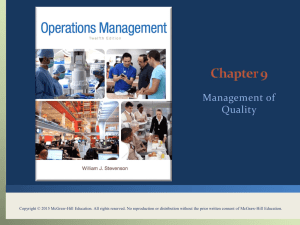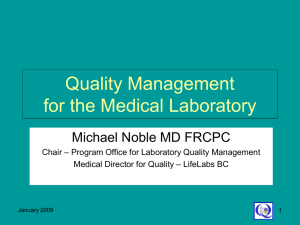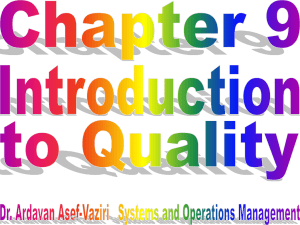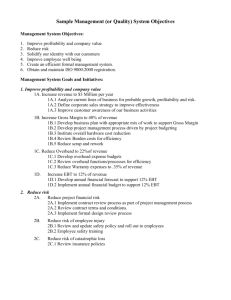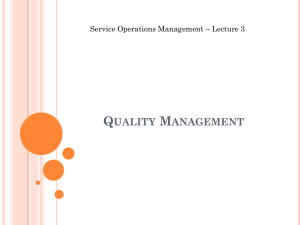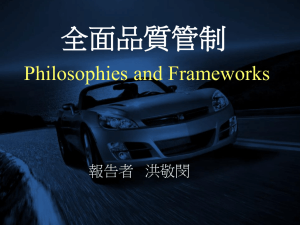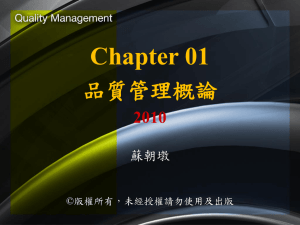Chapter 1
advertisement
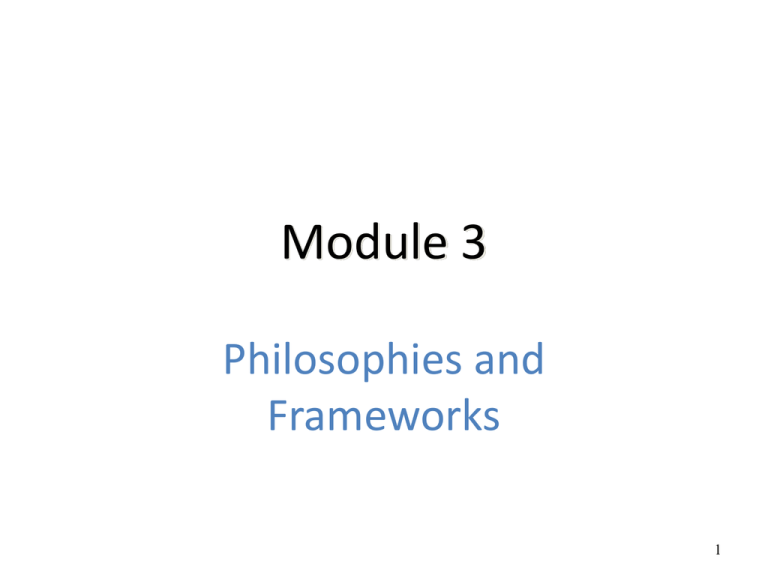
Module 3 Philosophies and Frameworks 1 Quiz • What were the 5 definitions of quality? – Transcendent (Excellence) – Product-Based – User-Based – Value-Based – Manufacturing-Based (Conformance, Little Q) 2 Medical Devices Case • What is Happening? (The Trend) • Margins for Improvement? – Quality Checks? – Feedback Analyses? – Benchmarks? • Transformations? • Customers? End Users? Quality Recognition? 3 Deming Chain Reaction Improve quality Costs decrease Productivity improves Increase market share with better quality and lower prices Stay in business Provide jobs and more jobs 4 Deming’s System of Profound Knowledge • • • • Appreciation for a system Understanding variation Theory of knowledge Psychology 5 Appreciation for a System • Most organizational processes are cross-functional • Parts of a system must work together • Every system must have a purpose • Management must optimize the system as a whole 6 Knowledge of Statistical Theory • Many sources of uncontrollable variation exist in any process • Excessive variation results in product failures, unhappy customers, and unnecessary costs • Statistical methods can be used to identify and quantify variation to help understand it and lead to improvements 7 Theory of Knowledge • Knowledge is not possible without theory (e.g. 2 + 2 = 4) – Riding a bicycle (Tacit & Explicit) • Experience alone does not establish a theory, it only describes • Theory shows cause-and-effect relationships that can be used for prediction 8 Knowledge of Psychology • People are motivated intrinsically and extrinsically • Fear is “generally” demotivating • Managers should develop pride and joy in work 9 Deming’s 14 Points (Abridged) (1 of 2) 1. Create and publish a company mission statement and commit to it. 2. Learn the new philosophy. 3. Understand the purpose of inspection. 4. End business practices driven by price alone. 5. Constantly improve system of production and service. 6. Institute training. 7. Teach and institute leadership. 8. Drive out fear and create trust. 10 Deming’s 14 Points (2 of 2) 9. Optimize team and individual efforts. 10. Eliminate exhortations for work force. 11. Eliminate numerical quotas and management by objectives (MBO). Focus on improvement. 12. Remove barriers that rob people of pride of workmanship. 13. Encourage education and self-improvement. 14. Take action to accomplish the transformation. www.deming.org 11 Juran’s Quality Trilogy 1) Quality planning, 2) Quality control, and 3) Quality improvement The Juran Trilogy® Quality Control (During Operations) Sporadic Spike (RCA/SCA) 40 Original Zone of Quality Control 20 Quality Improvement Quality Planning Operations Begin R6 New Zone of Quality Control Cost of Poor Quality Chronic Waste 0 Time 0 Lessons Learned 12 Phillip B. Crosby Quality is free . . . : “Quality is free. It’s not a gift, but it is free. What costs money are the unquality things -- all the actions that involve not doing jobs right the first time.” 13 Philip B. Crosby Absolutes of Quality Management: • • • • • Quality means conformance to requirements Problems are functional in nature There is no optimum level of defects Cost of quality is the only useful measurement Zero defects is the only performance standard www.philipcrosby.com 14 A.V. Feigenbaum • Three Steps to Quality – Quality Leadership, with a strong focus on planning – Modern Quality Technology, involving the entire work force – Organizational Commitment, supported by continuous training and motivation “Accountability for quality: Because quality is everybody's job, it may become nobody's job—the idea that quality must be actively managed and have visibility at the highest levels of management.” ~ Feigenbaum 15 Kaoru Ishikawa • Instrumental in developing Japanese quality strategy • Influenced participative approaches involving all workers • Advocated the use of simple visual tools and statistical techniques 16 Kaoru Ishikawa 17 Genichi Taguchi • Pioneered a new perspective on quality based on the economic value of being on target and reducing variation and dispelling the traditional view of conformance to specifications: Loss No Loss 0.480 0.500 Loss 0.520 Tolerance 18 Feedback Report • Strengths - approaches or results that demonstrate effective response to the Criteria • Opportunities for improvement - how the applicant can better address the purposes of the Criteria, or issues that require clarification 19 Sample Feedback Report Types 20 ISO 9000:2000 • Quality system standards adopted by International Organization for Standardization in 1987; revised in 1994, 2000, and 2005. • Technical specifications and criteria to be used as rules, guidelines, or definitions of characteristics to ensure that materials, products, processes, and services are fit for their purpose. 21 Objectives of ISO Standards (1 of 2) • Achieve, maintain, and continuously improve product quality • Improve quality of operations to continually meet customers’ and stakeholders’ needs • Provide confidence to internal management and other employees that quality requirements are being fulfilled 22 Objectives of ISO Standards (2 of 2) • Provide confidence to customers and other stakeholders that quality requirements are being achieved • Provide confidence that quality system requirements are fulfilled 23 Structure of ISO 9000 Standards • 21 elements organized into four major sections: – Management Responsibility – Resource Management – Product Realization – Measurement, Analysis, and Improvement 24 ISO 9000:2005 Quality Management Principles 1. 2. 3. 4. 5. 6. 7. 8. Customer Focus Leadership Involvement of People Process Approach System Approach to Management Continual Improvement Factual Approach to Decision Making Mutually Beneficial Supplier Relationships 25 ISO 9001:2008 ISO 9001:2008 sets out the criteria for a quality management system and is the only standard in the family that can be certified (although this is not a requirement). Checking that the system works is a vital part of ISO 9001:2008. An organization must perform internal audits to check how its quality management system is working. 26
